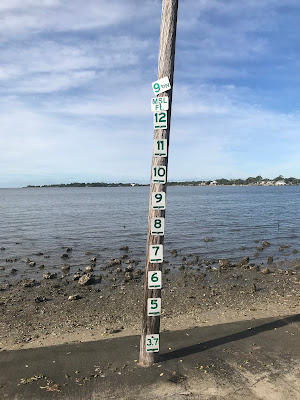Salt Marsh Voles. Part IV. the Hurricane and the Aftermath
My interest in the Long Cabbage Islands and the voles intensified a few years later when Hurricane Hermine came ashore in the Florida panhandle on September 2, 1916. The storm surge was variously reported at between seven and 11 feet in the Cedar Key area, and it certainly completely engulfed the Long Cabbage Islands.
What happened to the voles? Were they wiped out? Or were some individuals able to cling to a few protruding cabbage palms until the water subsided? And if some survived, were their tunnels and other workings in the mats of grass much disturbed, or even the grasses washed away? Had local populations, or maybe the entire subspecies, been extirpated?
I don’t know that these questions have ever been answered, but I suspect that the vole population pulled through. The favored habitats of voles are grasslands (and salt marshes are a kind of grassland). Much of their geographic range to the north is dominated by forests. Grasslands in forested areas are relatively rare and ephemeral, mainly resulting from disturbances like fires and blowdowns. Where grassy patches exist, they are subject to the gradual encroachment of trees and are almost sure to disappear in a few decades. Voles may be examples of “fugitive species”—biota whose habitats are unstable and short-lived. When their patches of grassland disappear, they must move on. They are adapted to find and rapidly exploit new habitat patches created by disturbances.
Looking into vole population biology sheds some light on their adaptations. Their tendency to “wander,” territoriality among breeding females, and the outward pressure produced by overproduction of offspring all favor expansion into newly available habitats. And they are prodigious reproducers, rivaling or outperforming rabbits. Female meadow voles studied in Pennsylvania reach reproductive maturity at 20 days of age, have from 2-11 offspring per breeding attempt, and can breed again in as little as three weeks, having as many as 12 litters in a year. The mathematics are simple, but the results are startling, nevertheless. In the unlikely event that breeding were left unchecked, in a year a single pair of voles could potentially produce more than 4,000 descendants.
So, the biological adaptations of voles fit well with unstable habitats because they allow pushing into newly available habitat patches and rapidly populating them. A few survivors from the storm surge overtopping the Long Cabbage Islands could rebuild the population to former levels in a relatively short time. Or descendants of survivors from other less damaged habitats might rapidly push into the newly vacant habitat.
Clearly glaciers have not directly influenced Florida landscapes in the past tens of thousands of years, and probably never. However, as is attested by the Florida salt marsh vole, the indirect influences of an ice age lasting until 10,000 years ago are clearly visible. And these effects may be dwarfed by changes in sea level on the scale of hundreds of thousands of years, in which the Florida peninsula expanded and shrunk as glacial ice alternately withdrew water from the oceans and released it. Salt marshes would have been repeatedly destroyed and recreated in response to moving shorelines. Perhaps sometime during past millennia suitable habitats and populations of the vole were distributed much more extensively.

No comments:
Post a Comment